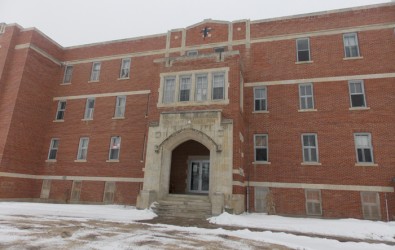Article Origin
Volume
Issue
Year
“It was a tiny little room, and it went about 30 feet in. It was just in the corner where these old, old pipes were… They said that’s where the kids were abused.”
Owen Morris, a teacher from Frog Lake First Nation, described a room he saw on a recent tour of the Blue Quills College in St. Paul. Blue Quills, a functioning college today, operated as a residential school between 1931 and 1970, and Morris was given a hands-on educational experience about what life was like for First Nations’ children who were students there during that time.
“There were no lights and we had to use our phones for flashlights. They said this was the room where a lot of abuse happened because they couldn’t hear screams.”
Morris was brave enough to explore the building’s “secret dungeon.” The room is a small space, attached to the side of the boiler room in the basement. Morris was saddened by what he saw as he also has family members who attended residential school. Seeing a school in person had an impact on him.
“Because you’re there, you feel the tiles... The way it’s set up is very military-like, and you can just imagine the little line-ups of children waiting for everything. You get to experience it more than just reading about it,” he said.
Blue Quills First Nations College offers a variety of certificates, diplomas, and degrees. In direct contrast to the years it served as a residential school and took away the language of its children, the college offers programs in the Cree language. Over the years, the college has occasionally given guided tours. But the requests for tours have become more frequent since the Alberta government’s announcement that residential schools be included in the curriculum, said Sharon Steinhauer, director of the social work program, and one of the school’s main tour guides.
“More are calling all the time. Alberta Education has made a commitment to do a kindergarten to grade 12 residential school curriculum, and that’s not available yet, so schools don’t have a lot of hands-on, ready resources. Which is why they look to us to provide that,” said Steinhauer.
Steinhauer’s tours include a discussion of the intergenerational impact of residential schools, as well as handouts, and a guided walking tour around the entire building. Tours typically end with a debriefing circle, because seeing the school can have a traumatic effect on visitors.
“The tour is a triggering experience for Elders. That unresolved anger, fear and grief… Sometimes we’re doing that kind of work,” said Steinhauer. “I think it’s a bit of an eye opener for some people, because then it’s no longer a history lesson... It’s a living lesson.”
Elder Cecile Dion was part of the group from Frog Lake. She found the atrocities the children faced became clearer as she wandered from room to room. Dion was particularly disturbed by the lack of space in the children’s dormitories, and wondered how they would have survived the summer heat, being so crowded.
“You would get depressed, and go silent, thinking of what our young people went through. It was nice to go, but the story you hear, it just hurts you,” she said.
Photo caption: The Blue Quills building had a concrete cross located centered on the roof above the front entrance, but it was knocked down in March 2007 by the Blue Quills president.
- 3805 views

